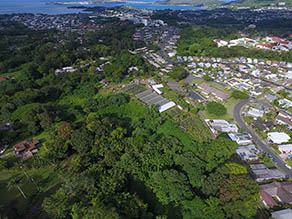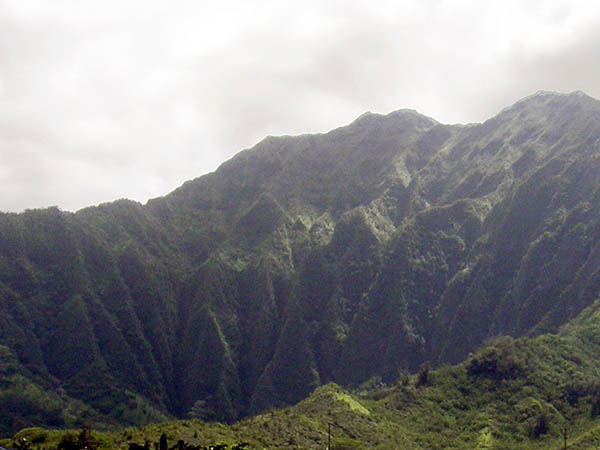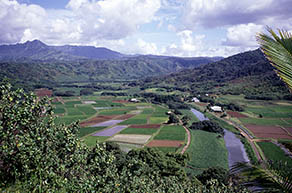 |
 |
 |
 |
||||||
|
|
|
|
|
|
|
|
|
|
 |
|
 |
|||||||||||
 |
“How do you move a 21st century project for traditional systems?” Kanekoa asks. “It’s getting people back on the land, yet still keeping their jobs, still keeping the way of their life, their cultures now, and trying to balance that out. That’s always been a challenge for us. To get our people back on this land, we’ve offered it to families, offered it to people and just tried to be as open as we can with everything. “For these landowners here, their value has gone up 200%. When you overlook Hanalei Valley, which is all in taro, people are happy. From our community’s perspective, the kūpuna that have fought to preserve this land would like to see it in taro. We hope to get that process going where it’ll all be in taro and protected in taro, and so they’ll be happy. For the most part, everybody has been supportive.” Read about the NERR designation. “A decade ago ‘ahupua‘a’ was something that people were talking about,” Keoni says, “and looking at how we could implement that sense of ahupua‘a and the resource-management perspectives and the human interaction perspectives, and all the things that enable ahupua‘a to be a sustainable system. Within that discussion, we saw the basic unit of an ahapua‘a as essentially kauhale, and so we started focusing on the kauhale. If we’re going to build an ahupua‘a, we need to start with kauhale. Others started with kauhale as well in some sense. Rick talks about water management at Waipao. “Kauhale at one level is the extended-family unit. At another level, it’s the multipurpose household that encompasses the key resources—food resources essentially—that a household needs. Other resources we might look at within a kauhale are the knowledge resources. A kauhale is sustainable because there are knowledge systems within that family that are being perpetuated, and kuleana is being passed from one generation to the next. So we saw that as a fundamental building block to ahupua‘a, which is a building block to a larger sense of lāhui, and prosperity and wellness across our lāhui.
“There are so many systems, and sometimes it’s easy to focus on the physical systems because they’re there. Archaeologists focus on the physical systems. I think it’s much easier to focus on the physical than looking at all the intellectual, emotional, spiritual systems that are actually driving the expression of physical systems. The physicality of a kauhale is about function: the hale mua isn’t just a building, it’s a space with particular function, and that function is related to the culture and the perspectives of the people living in that kauhale. So that was one of our key foundational elements, and it’s something that is imbued in our approach to mālama ‘ āina. “Between our three organizations—with Kako‘o ‘Ōiwi and Paepae o He‘eia—there’s a lot of connectivity. I wouldn’t venture to say it’s ahupua‘a yet, but it’s getting there. I think we need to be more inclusive of everyone else in the ahupua‘a that has a vision for ‘āina, and see how we can continually build our collaborations and a collective vision. I think it’s easy to create pockets—especially as a Hawaiian, I feel like I have cultural pockets all over the place. And it’s easy to become blind to the fact that this is really actually a small pocket in a much larger system. 
“And so I think reaching out to our public schools is one way to engender ahupua‘a—reaching out to our communities, getting people to see what’s happening, and engage them with what’s happening on ‘āina. I think that’s another step in the right direction. “I don’t feel that we’ve reached out enough to the neighbors. At the beginning of our development, the neighbors were actually in some sense a threat, because they could complain about any buses going through, and find issue with what we’re doing there. I think over the years, we have with some neighbors a friendly relationship, a mutual respect. I think most neighbors in our immediate community don’t even know we’re there. We’re working on that, and actually we’ll soon have a little letter going out to everybody in our immediate vicinity. More about uniting different He‘eia-based groups into an ahupua‘a model “Many people, they see what we’re doing—they don’t quite know what we’re doing, but they appreciate the physical changes that we brought to the space. There are people who walk their dogs on the old Ha‘ikū road that we’re managing, and have seen how things have evolved in the past ten years. So it’s a constant process.”
|
 |
|
 |
Of course, the other half of the ahupua‘a brings us to what is happening with the Sea Today.
|
 |
||
 |
|
 |
||

|
 |
||||
|
||||
Copyright 2019 Pacific Worlds & Associates • Usage Policy • Webmaster |
||||



